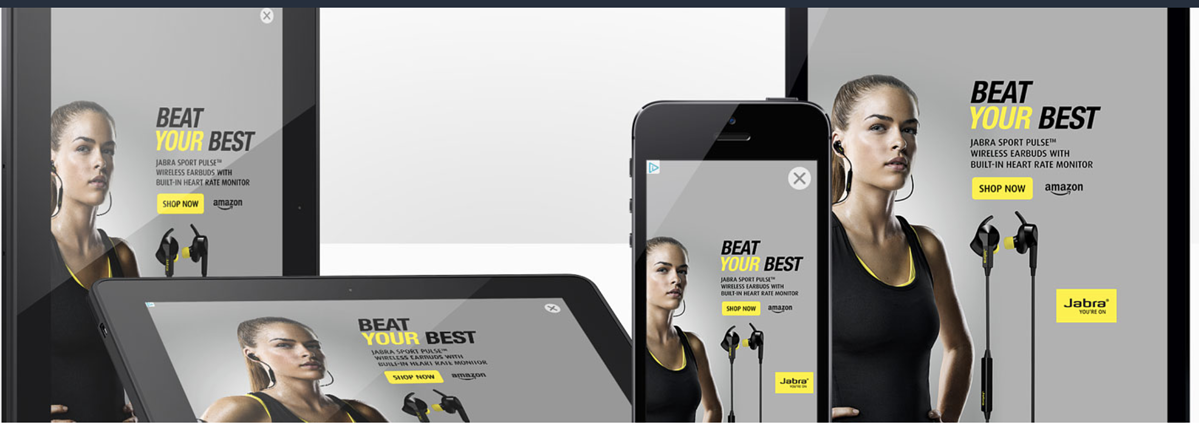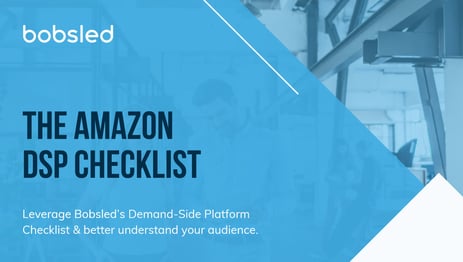Amazon DSP can help brands who are ready to grow engagement and sales during the pandemic.
If your brand has performed strongly on Amazon since COVID-19 began impacting the retail landscape, you may now be thinking “what next?”
Amazon Demand-Side Platform (DSP) is an advertising platform that lets brands reach potential customers efficiently and effectively at scale, a godsend for certain brands during this high demand period. Amazon’s unique advantage is that it lets advertisers programmatically buy display and video ads using customer targeting data only available through Amazon.

At Bobsled, we’ve seen firsthand how DSP has been transformative for our clients throughout this unprecedented time. In this article we’re going to walk you through the nuts and bolts of Amazon DSP and explain how brands should be thinking about scaling right now. We’ll also share and analyze a DSP case study.
Amazon DSP Program - The Nuts & Bolts
Amazon’s DSP program facilitates the buying and selling of select digital advertising placements on Amazon.com as well as websites, social media platforms, mobile apps and/or online video channels. The pricing is based on a dynamic Cost Per Thousand (CPM) model. Unlike a fixed CPM, dynamic pricing allows advertisers to adjust their bid price, which promotes highly efficient spending.

Above: Example of a DSP Mobile Interstitial Ad, a full screen ad served inside mobile apps during natural transition points.

“Amazon has an incredible amount of useful shopper data,” says Bobsled Advertising Director Stefan Jordev.
“DSP advertisers are overwhelmed with behavioral, contextual, and demographic insights which they can analyze to better understand their audience. In my opinion, this is the true value of DSP.”
At Bobsled, we have two broad strategies for DSP.
- Brand Awareness. This approach focuses on exposure metrics for customers that want exposure to a larger audience. We judge performance based on impressions, click-throughs and Detail Page Views (DPV).
- Sales Driven. This approach is focused on Return on Ad Spend (ROAS) involving the retargeting of potential customers, remarketing to existing customers and targeting in-market customers. This strategy is suitable for advertisers who have maxed out their reach with Amazon PPC and are looking to expand further.
“In general, the immediate return on investment for DSP is lower than Amazon Advertising PPC ads,” Stefan says. “Therefore, DSP is typically more suited to building brand and product awareness rather than driving direct sales. This needs to be top of mind for brands as they navigate through the turbulence of Covid-19.”
Should I Use Amazon DSP During Covid-19?
Ross Walker, Bobsled PPC Manager, has some guiding principles in relation to DSP and Covid-19.
“Amazon DSP campaigns are great for brands that want to create more demand for their products,” Ross says. “Immediately that rules out brands who would not benefit from an increase in demand at this time e.g. brands with supply chain issues. Also, if you’ve noticed an undeniable drop in demand for your product line since Covid-19 hit across all channels, DSP is likely not going to be the lever that gets things back on track. Brands in this position are better off hunkering down, getting their PPC ad spend as lean as possible, and exploring DSP in the future after the dust has settled.”

According to Ross, brands that are really serious about building brand awareness and consideration during the time of the “quarantined consumer” are turning to DSP.
“Browsing traffic is high right now with elevated ecommerce shopping. People have more time to browse through several options before making a purchase,” Ross says. “Brands that are using DSP can leverage this high traffic volume in a multitude of ways. For example, you’re able to aggressively retarget viewers of your product pages as a way to really push brand awareness.”
-3.png?width=960&name=pasted%20image%200%20(1)-3.png)
Above: Bobsled’s Amazon DSP Brand Awareness Funnel. The typical “Quarantined Consumer” is spending more time browsing online compared to their pre-Covid routine (Awareness & Consideration phases).
By building an audience of viewers now, brands can capitalize later when customers are ready to pull the trigger and open their wallets.
“One final point is that Amazon CPCs (Cost per Click) have been elevated with a lot of advertisers piling in to try and capitalize on increased ecommerce. So competition within the Amazon Advertising PPC space is fierce within booming categories,” Ross explains. “But here’s the thing: DSP is not a known entity for many brands. Expanding your reach means you can leverage audience insights from Amazon and have lower competition for eyeballs with off-Amazon and DSP-only ad inventory.”
[FREE RESOURCE] THE AMAZON DSP CHECKLIST
Grow Brand Awareness Now

This free PDF will give you a thorough explanation of Amazon DSP and how to align it strategically with your brand goals. And in addition to our DSP checklist & best practices, we’ve also included a DSP case study from one of our clients here at Bobsled.
How Do I Get Started With Amazon DSP?
“Amazon DSP is not something you should jump into blind without a considered plan,” Ross says. “But I appreciate there are brands who know there’s an opportunity to shore up their business during Covid-19 through Amazon DSP advertising, and they need to move quickly. So I’ve put together the DSP set-up checklist below which summarizes all the steps, broadly speaking.”
1. Set Up (establish KPI, set up advertiser, order, line levels):
- Sales Driven
- (ROAS/CPP)
- Brand Awareness
- Detail page view rate (DPVR)
- Click through rate (CTR)
- Viewability goal
- Video completion rate (VCR)
- Brand lift (via Nielsen DBE study)
2. Review
- Campaign budget
- Line item setup
- Flight dates
- Pixel association
- ASIN association
- Optimization - Leverage automatic optimization, use manual optimization levers
- Report - dashboard and reports
3. Pre optimization checklist:
- Confirm the campaign's goal and KPI.
- Check ASINs associated with the order (for brands that sell on Amazon).
- Check that the correct pixels are associated with the order.
- Confirm that budget allocation is correct.
- Confirm campaign flight times.
- Check that line items are correct.
- Check that accurate audience segments are selected.
- Check if creative assets are correct.
4. Wait until at least 30% of campaign period has expired before making optimizations
5. Variables that can impact performance
- High Volume Shopping Holidays
- Covid-19 Fulfillment Problems
- Out-of-stock issues
- Poor customer reviews
- Weather conditions

Amazon DSP Covid-19 Case Study
A Bobsled client in the fashion space has achieved their best programmatic advertising performance over the last month since their DSP account was created.
- The purchase goal was achieved primarily through retargeting non-purchasing visitors to the client’s top pages.
- Total ROAS and Total Product Sales are at all time highs in April. Average ROAS is 2 times level in February and trending at over 3 times February levels this week.
- Part of Bobsled’s efforts to revitalize DSP for the client during this Covid-19 period included implementing fresh creative, and focusing on driving traffic to the storefront pages to shorten the path to purchase/increase conversion rates.
- After observing performance trends for a couple of weeks the Bobsled team culled creative assets that weren’t performing as strongly as others, doubling down on the best performers. This change helped increase ROI significantly.
- Our next step is to achieve the client’s brand awareness goal by building out ads for the target customers in the market for their products but aren't yet aware of their brand.

Above: Dashboard screenshot of the significant DSP performance uptick noted in April for Bobsled’s client.
NEED HELP UNDERSTANDING & IMPLEMENTING AMAZON DSP?
If DSP is the right solution for your brand, now is the time to learn more.
A Bobsled expert is just a couple of clicks away. Click the button below and complete the form to request a consult - it’s free and there’s no commitment involved.
Tagged: PPC Advertising, Seller & Vendor Central, Amazon Display Advertising, DSP
.png)


